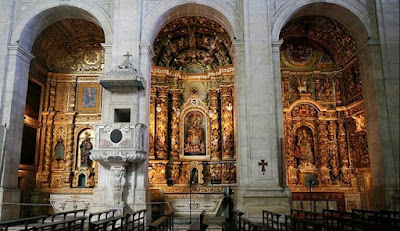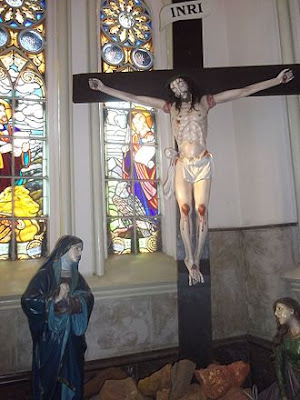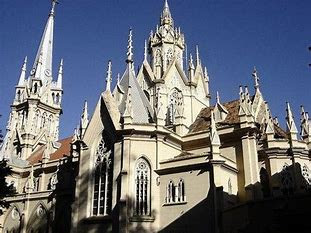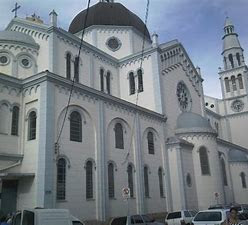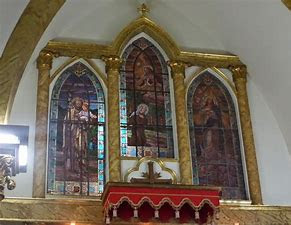Brazil—6
This blog will discuss seven Catholic provinces in Brazil’s civil states of Bahia, Espirito Santo, Rio de Janeiro, and Sergipe in eastern Brazil.
Please see my previous blogs on Brazil:
- Brazil 1 published on September 6, 2019
- Brazil 2 published on September 9, 2019
- Brazil 3 published on September 1, 2020
- Brazil 4 published on September 8, 2020
- Brazil 5 published on September 1, 2021
Province of Sao Salvador da Bahia
The province consists of the eastern portion of the civil state of Bahia. The Diocese of Sao Salvador da Bahia de Totos os Santos was created in 1551 and became the Metropolitan Archdiocese of Sao Salvador da Bahia in 1676.
The Cathedral Basilica of the Transfiguration of the Lord in Salvador was built by the Jesuits between 1657 and 1672. The two bell towers were not completed until 1694 and the façade was not finalized until 1746. The building became a diocesan church after the Jesuits were expelled from Brazil in 1759. The church became the Cathedral for the Archdiocese in 1933 after the previous 16th Century cathedral was demolished. The Cathedral was built in the Mannerist style and has two bell towers. The façade is made of lioz stone from Portugal and has statues of Jesuit saints. The interior is also lined with lioz stone and has several chapels. The chapels reflect different time periods and architectural styles, including Renaissance, Baroque, and Mannerist. The late 17th Century sacristy is lined with jacaranda wood and has baroque furniture and several paintings. Pope Pius XI named it a minor basilica in 1922.
Pictures are from Wikipedia, local sources, and from the Archdiocesan website.
The Province has eight suffragan dioceses.
- The Diocese of Ilheus was created in 1913.
- The Diocese of Amargosa was created in 1941.
- The Diocese of Teixeira de Freitas-Caravelas was created in 1962.
- The Diocese of Alagoinhas was created in 1974.
- The Diocese of Itabuna was created in 1978.
- The Diocese of Eunapolis was created in 1996.
- The Diocese of Camacari was created in 2010.
- The Diocese of Cruz das Almas was created in 2017.
Province of Sao Sebastiao do Rio de Janeiro
The province consists of the southwestern portion of the civil state of Rio de Janeiro. Sao Sebastiao do Rio de Janeiro was established as a territorial prelature in 1575, became a diocese in 1676, and was promoted to a metropolitan archdiocese in 1892.
The Cathedral of St. Sabastian in Rio de Janeiro was built in a modern style between 1964 and 1979 and is based on Mayan architecture. The Cathedral is 246 feet high and can seat 5,000—standing room capacity is 20,000. It covers 86,000 square feet and is the largest cathedral in South America. Four rectilinear stained glass windows are 210 feet from floor to ceiling.
All pictures are from Wikipedia.
The Province has five suffragan jurisdictions.
- The Diocese of Barra do Pirai-Volta Redonda was created in 1922.
- The Diocese of Valenca in 1925.
- The Diocese of Nova Iguacu was created in 1960.
- The Diocese of Itaguai was created in 1980.
- The Diocese of Duque de Caxias was created in 1980.
Province of Vitoria
The province consists of the civil state of Espirito Santo. The Diocese of Espirito Santo was created in 1895 and this became the Metropolitan Archdiocese of Vitoria in 1958.
Our Lady of Victory Cathedral is in Vitoria and replaced an older cathedral. Construction began on the current cathedral in 1920 and it was dedicated in 1933 although construction continued until the 1970s.
The first picture is from Wikipedia and the other two are from local websites.
The Province has three suffragan dioceses.
- The Diocese of Cachoeiro de Itapemirim was created in 1958.
- The Diocese of Sao Mateus was created in 1958.
- The Diocese of Colatina was created in 1990.
Province of Niteroi
The province consists of the northeastern portion of the civil state of Rio de Janeiro. The Diocese of Niteroi was created in 1892 and was promoted to metropolitan archdiocese in 1960.
The Cathedral of St. John the Baptist in Niteroi was built between 1842 and 1885 in a colonial style with two bell towers. Internal decorations were completed in 1929 by an Italian artist. A new cathedral designed by Oscar Niemeyer is under construction.
All pictures are from Wikipedia.
The Province has three suffragan dioceses.
- The Diocese of Campos was created in 1922.
- The Diocese of Petropolis was created in 1946.
- The Diocese of Nova Friburgo was created in 1960.
Province of Aracaju
The province consists of the civil state of Sergipe. The Diocese of Aracaju was created in 1910 and became a metropolitan archdiocese in 1960.
Our Lady of the Conception Cathedral in Aracaju was built of stone between 1862 and 1875 using neo-classic and neo-gothic architectural styles. The interior features extensive artwork done by Italian and local artists. The cathedral has a central dome and two domed towers—the tower domes are covered with pebbles and sea shells.
Pictures are from the Archdiocesan website, Wikipedia, Mapio, and Pinterest.
The Province has two suffragan dioceses.
- The Diocese of Estancia was created in 1960.
- The Diocese of Propria was created in 1960.
Province of Feira de Santana
The province consists of the northwestern portion of the civil state of Bahia. The Diocese of Feira de Santana was created in 1962 and was promoted to a metropolitan archdiocese in 2002.
Portions of St. Ann Cathedral in Feira de Santana date to 1732, but it was enlarged and renovated in the mid-19th Century. The façade has three arched portals topped with windows and is flanked by two bell towers. The Cathedral covers over 10,000 square feet.
The Province has eight suffragan dioceses.
- The Diocese of Barra was created in 1913.
- The Diocese of Bonfim was created in 1933.
- The Diocese of Ruy Barbosa was created in 1959.
- The Diocese of Juazeiro was created in 1962.
- The Diocese of Paulo Afonso was created in 1971.
- The Diocese of Irece was created in 1979.
- The Diocese of Barreiras was created in 1979.
- The Diocese of Serrinha was created in 2005.
Province of Vitoria da Conquista
The province consists of the southwestern portion of the civil state of Bahia. The Diocese of Vitoria da Conquista was established in 1957 and became a metropolitan archdiocese in 2002.
The Cathedral of Our Lady of Victories in Vitoria da Conquista was built in a Neo-gothic style between 1932 and 1944.
Pictures are from Foursquare, TripAdvisor, and Wikipedia.
The Province has four suffragan dioceses.
- The Diocese of Caetite was created in 1913.
- The Diocese of Bom Jesus da Lapa was created in 1962.
- The Diocese of Livramento de Nossa Senhora was created in 1967.
- The Diocese of Jequie was created in 1978.
Definitions
The Catholic Church is mostly divided into ecclesiastical provinces—a province consists of a metropolitan archdiocese and one or more dioceses. The province and the archdiocese are led by an archbishop. Each of the dioceses is called a suffragan diocese and is led by a bishop. Archbishops have some responsibilities for the province, but all bishops answer directly to the Pope. There are also missionary jurisdictions below the level of a diocese, such as territorial prelatures.
A basilica is an honorary title bestowed on a church by the Pope because of the church’s antiquity, dignity, historical importance, or significance as a center of worship. Some cathedrals are also basilicas. Each basilica has a ceremonial umbrella in the papal colors of white and yellow and a ceremonial bell. Both of these are symbolic of the Pope’s special relationship to the basilica.

